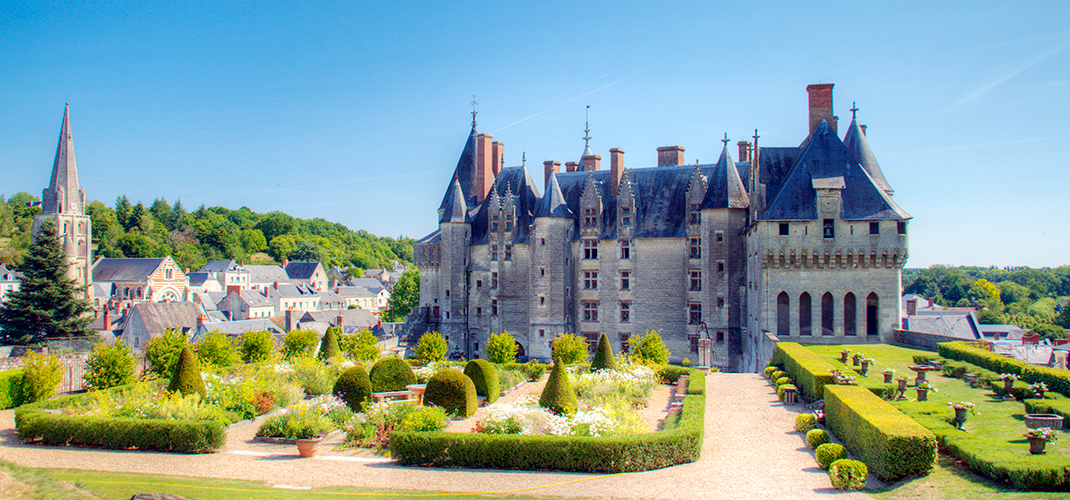Loire Valley

The UNESCO Listed Val de Loire welcomes its visitors to a fairytale like scene, complete with stunning Castles and a captivating countryside. The area is called the ‘Garden of France’ due to its natural beauty and is truly one of the most fascinating places to visit in France.
One of the most grandiose Châteaux is the Château de Chambord, it is the most emblematic Renaissance monument in France. This 16th Century Royal Château is a breathtaking site to behold, sitting on over 5,500 hectares of parkland. Created for François I, the Château has turreted towers, impressive vaulted ceilings, 440 rooms and a gigantic double helix staircase in the entry hall.
Château de Chenonceau was greatly influenced by the famous women who once lived here. In 1535, the Château became the property of Henry II, who presented the Château to his mistress Diane de Poitiers in 1547. However, it was Henry's widow Catherine de Médicis who was responsible for creating the most unique feature of the Château, the Corps de Logis. This two story gallery stands upon a graceful arched bridge that crosses the River Cher, giving the impression that the Château is floating on water. The exquisitely landscaped gardens of the Jardin de Diane de Poitiers and the Jardin de Catherine de Médicis equal the Château’s beauty.
Built along the left bank of the River Loire is the medieval town of Amboise with the stunning Château Royal d'Amboise, where French Kings resided for five centuries. Built during the 15th Century reign of Charles VIII, the Castle exemplifies late Gothic architecture and has a richly articulated façade and imposing round towers. Situated within the Château is the Chapelle Saint-Hubert, built for King Charles VIII and his wife Anne de Bretagne. The Chapel is a fine example of Gothic architecture with intricate sculptures and gargoyles on the façade, brilliant stained glass windows and is the final resting place of Leonardo da Vinci. Nearby in the Château du Clos Lucé is where Leonardo da Vinci spent his final three years and where visitors can learn all about this great Renaissance man.
The 17th Century Château de Cheverny is one of the most enchanting Loire Valley Castles and has been home to the same family for more than six centuries. The grand halls and the well maintained apartments of the Château are graced with the original furniture and décor, such as a 17th Century Gobelin Tapestry and a Louis XIV chest, which provides an insight into noble life centuries ago.
The Château de Villandry is renowned for its gorgeous grounds including a Kitchen Garden and a Herb Garden created during the Renaissance era. The formal 16th Century Ornamental Garden with the methodical rows of manicured shrubbery and tidy flower beds distinguish the landscaping.
Dating back to the 10th Century, The Forteresse Royale de Chinon sitting high above the town, is a masterpiece of medieval architecture. It was here on March 9, 1429 that Joan of Arc had an important meeting with the Dauphin Charles at the Fortress. During this meeting, Charles was convinced to send his army to end the siege of Orléans, a pivotal event during the Hundred Years War and to become King, later being crowned Charles VII in Reims. Nearby is the fairytale Château d'Ussé, which inspired Charles Perrault to write ‘Sleeping Beauty’. This privately owned Château is home to the Duke of Blacas and his family and boasts a grand staircase.
Standing on an island in the Indre River, the 16th Century Château d'Azay-le-Rideau has the appearance of a mythical Castle with the façade's reflection in the placid waters creating a dreamlike impression. In the town of Azay-le-Rideau you will find the Église Saint-Symphorien, which blends both Romanesque and Gothic styles. Just 10 kms away in the Langeais town centre, the Château de Langeais was rebuilt by Louis XI in 1465 and this striking landmark has remained unchanged for centuries. Close by is the historic town of Loches with its old world charm, alluring gardens and picturesque scenery. Sitting on the hill the Cité Médiévale, (medieval city) is fortified by a 2 km circuit of Ramparts.
The Loire Valley is dotted with many stunning Châteaux, some of the other notable ones to include on your visit are the Château de Villesavin, Chateau de Brissac, the Château de Beauregard, Château de Montreuil-Bellay, Château d'Angers, Château de Châteaudun and the Château de Valençay.
One of the largest surviving medieval Monasteries in Europe is the Abbaye Royale de Fontevraud. This Benedictine Abbey was founded in 1099 and is nestled in a verdant valley. Queen Eleanor of Aquitaine, wife of King Henry II of England had strong ties to the Abbey, which was her favorite place of worship.
In the little village of Saint-Benoît-sur-Loire, the Abbaye de Fleury is an oasis of peace and spirituality. The architecture and the rural setting creates a sense of tranquillity that is ideal for meditation. This 7th Century Benedictine Abbey and its Basilica is one of the finest Romanesque Churches in France.
The historic city of Tours with its cobblestone streets is a beautiful place to stroll around especially between the Place Plumereau and the Place du Grand-Marché. The Old Town is tree lined with courtyards, cafés and half-timbered houses. Here you can admire The Cathédrale Saint-Gatien and its flamboyant Gothic façade as well as the glorious vaulted Sanctuary, illuminated by 13th Century stained glass windows. The Musée des Beaux-Arts de Tours, showcases masterpieces of fine art from the 14th-20th Centuries, including paintings by Rubens, Rembrandt, Delacroix, Degas and Monet.
The largest town in the Loire Valley after Tours is Orléans making it a great base to explore the region. Inseparably bound with the history of Joan of Arc, the city owes its survival to the 17 year old ‘Maid of Orléans’ who helped lead the French to victory against the English in 1429. The Maison de Jeanne d'Arc is a museum devoted to Joan of Arc, who is now recognised as a Saint by the Catholic Church. Another landmark associated with Joan of Arc, is the 13th Century Cathédrale Sainte-Croix with its monumental exterior featuring twin 81 metre high towers, five doorways in an elaborate Baroque style.
Blois is distinguished by its architecture and old world charm, reflecting the grandeur of past residents, half-timbered burghers' houses and medieval cobblestone streets including the Rue Pierre de Blois alley, the steps of the Rue Denis Papin and the Rue du Puits Châtel, which traverses the Old Town and includes pedestrian staircases with scenic views. The stunning Château Royal de Blois was once the home to the Kings of France and the Cathédrale Saint-Louis, both overlooking the spectacular Loire Valley.
The charming Old Town of Chartres is famous for its UNESCO Listed Cathédrale Notre-Dame de Chartres. This awe inspiring 12th-13th Century French Gothic Church stands with its soaring spires visible from afar and is most renowned for its abundance of intricately detailed medieval stained glass windows.
The medieval town of Saumur is at the heart of the historic Anjou region where the pastoral landscape is dotted with woodlands, vine covered hills and flower fields. Saumur has one of the most impressive of the Loire Valley Châteaux, built in the 14th Century the Château de Saumur was the property of the Counts of Anjou. The Château de Saumur contains the Musée de Saumur, which has a collection of decorative works of art, furniture, tapestry and ceramics from the 14th-18th Centuries.
